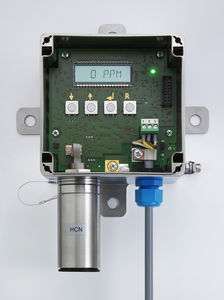
Gas detector Statox 501 LC IR / MC IRinfraredmonitoringfixed

Add to favorites
Compare this product
Characteristics
- Detected entity
- gas
- Technology
- infrared
- Application
- monitoring
- Other characteristics
- fixed
Description
Monitoring the environment for explosive gases most of the time you would be looking for hydrocarbons. It is a characteristic of hydrocarbons that they have a number of C - H bonds. These bonds absorb infrared light at a wavelength of 3,4 mm ( unsaturated hydrocarbons absorb at 3,3 mm ). This effect can be used to reliably detect these substances
The most important advantage is that they are resistant against catalyst poisons and high concentrations. They can even be used in oxygen free atmosphere.
Another important advantage of this technology is that a failure cannot go unnoticed. If an important component such as the lamp or the detector fails, the system will recognise this as 100 % absorption (an alarm situation). Most infrared gas detectors are designed as so - called NDIR (Non Dispersive Infra Red) double- beam detectors. This means, the light beam is divided in two portions with different wavelengthes. One is the measuring beam that will be absorbed by gas, the other is a reference beam at a wavelength that will not be absorbed by gas. This beam compensates for intensity variations of the lamp, dirt and corrosion. As the optics are mostly self maintained, an eventual inspection only checks if there is gas access to the sensor. Therefore much longer maintenance intervals compared to the catalytic sensor can be justified. As a rule of thumb, twice as long is OK.
For plants which already have installed a combustible gas detection system, there is now a chance for a very cost- effective upgrade: The Statox 501 LC IR or LC MR!
Catalogs
No catalogs are available for this product.
See all of COMPUR MONITORS‘s catalogs*Prices are pre-tax. They exclude delivery charges and customs duties and do not include additional charges for installation or activation options. Prices are indicative only and may vary by country, with changes to the cost of raw materials and exchange rates.




